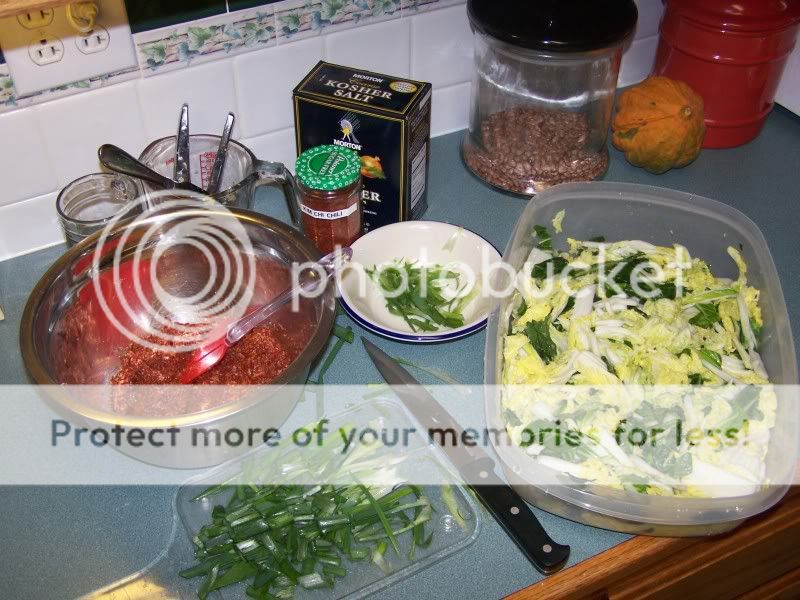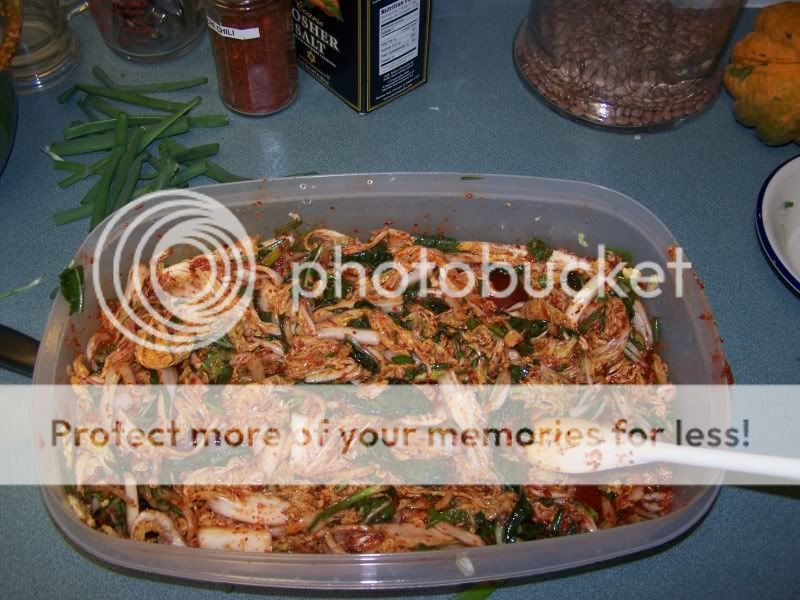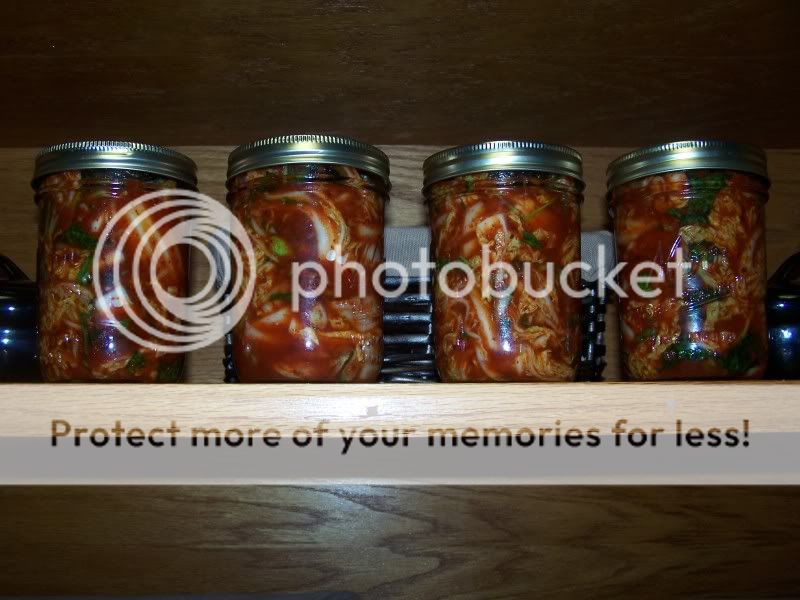
 1
1




 . In the bowl is 3/4 cup korean pepper flakes, 1.5 heads of garlic, and salt. waaaay too much salt. the cabbage hase been brined and then rinsed several times and is wilted significantly. brining before or not seems to be a bit controversial. I just went with it. my sil recipe is lost so I picked one off the net. It called for 1 whole cup of salt along with the pepper and garlic (outside the brine and mixed with the cabbage). I knew that was way too much for me so I cut it down to near or less then 3/4 cup. still too much. I eliminated the ginger from the recipe and decided to forego any of the other optional ingredients because I know i liked my sil's recipe and it had neither of these. I do remember she added thinly sliced green onion so thats what I did.
. In the bowl is 3/4 cup korean pepper flakes, 1.5 heads of garlic, and salt. waaaay too much salt. the cabbage hase been brined and then rinsed several times and is wilted significantly. brining before or not seems to be a bit controversial. I just went with it. my sil recipe is lost so I picked one off the net. It called for 1 whole cup of salt along with the pepper and garlic (outside the brine and mixed with the cabbage). I knew that was way too much for me so I cut it down to near or less then 3/4 cup. still too much. I eliminated the ginger from the recipe and decided to forego any of the other optional ingredients because I know i liked my sil's recipe and it had neither of these. I do remember she added thinly sliced green onion so thats what I did.


[img]http://i109.photobucket.com/albums/n52/havlik1/permie%20pics2/permiepotrait3pdd.jpg[/img]
"One cannot help an involuntary process. The point is not to disturb it. - Dr. Michel Odent
 2
2








I want all the goodies from the fermentation process as I can get and still get a yummy kimchi. it seems alot of the recipes are just 'pickled' not really fermented. that would explain the high salt of some of them and the little to no fermentation outside of the fridge.





 ops:
ops:







[img]http://i109.photobucket.com/albums/n52/havlik1/permie%20pics2/permiepotrait3pdd.jpg[/img]
"One cannot help an involuntary process. The point is not to disturb it. - Dr. Michel Odent








Pepper fruits are added at a substantial quantity to produce a characteristic taste of cuisine of West Sumatran (Indonesia). It was observed that cuisine using a large amount of chilli pepper could stand at long period without significant deterioration. Only a special variety of chilli pepper was employed by this ethnic, i.e. Capsicum annuum L. var. longum (Solanaceae) which has a curly shape. Chilli tinctur was previously reported to be able to inhibit the growth of Staphyllococcus sp., Escherichia coli, Bacillus aureus and Bacillus subtilis1). In Madura island (Indonesia), chilli pepper (Capsicum frutescens) is traditionally used to treat ox cuts before race2). In Indonesia, chilli pepper is also traditionally used to treat oral thrush which is usually caused by Candida albicans3).
"the qualities of these bacteria, like the heat of the sun, electricity, or the qualities of metals, are part of the storehouse of knowledge of all men. They are manifestations of the laws of nature, free to all men and reserved exclusively to none." SCOTUS, Funk Bros. Seed Co. v. Kale Inoculant Co.




[img]http://i109.photobucket.com/albums/n52/havlik1/permie%20pics2/permiepotrait3pdd.jpg[/img]
"One cannot help an involuntary process. The point is not to disturb it. - Dr. Michel Odent




Leah Sattler wrote:I did find a blurb somewhere about how napa cabbage has more sugar in it, maybe that makes it ferment quicker?
sounds like the pepper does alot to help with the suppression of the icky stuff so it can only be easier than plain kraut...
"the qualities of these bacteria, like the heat of the sun, electricity, or the qualities of metals, are part of the storehouse of knowledge of all men. They are manifestations of the laws of nature, free to all men and reserved exclusively to none." SCOTUS, Funk Bros. Seed Co. v. Kale Inoculant Co.




[img]http://i109.photobucket.com/albums/n52/havlik1/permie%20pics2/permiepotrait3pdd.jpg[/img]
"One cannot help an involuntary process. The point is not to disturb it. - Dr. Michel Odent













[img]http://i109.photobucket.com/albums/n52/havlik1/permie%20pics2/permiepotrait3pdd.jpg[/img]
"One cannot help an involuntary process. The point is not to disturb it. - Dr. Michel Odent
 1
1





 4
4




Works at a residential alternative high school in the Himalayas SECMOL.org . "Back home" is Cape Cod, E Coast USA.
 1
1









 1
1




 4
4




 3
3




"Them that don't know him don't like him and them that do sometimes don't know how to take him, he ain't wrong he's just different and his pride won't let him do the things to make you think he's right" - Ed Bruce (via Waylon and WIllie)
 1
1




 2
2




Saralee Couchoud wrote:Can this be made without the spice. I don't do even a little spicy. Thanks
My new cookbook Fearless Fermenting is out!
Get your copy on Amazon or get one autographed from me on my website!
 3
3




Saralee Couchoud wrote:Can this be made without the spice. I don't do even a little spicy. Thanks
 2
2




Saralee Couchoud wrote:Can this be made without the spice. I don't do even a little spicy. Thanks
 9
9




 4
4





 4
4




Leila Rich wrote:It's nearly kimchi season for you Northerners...
I had lots of bok choy and wom bok that were transplanted late and never got decent root systems going.
They're either bolting or being massacred by slugs/snails.
wom bok, bok choy, giant red mustard, red Russian kale
The self-sown daikon radishes are still tiny. I thinned them out.
The garlic chives are resprouting. I chopped off all the mature leaves
I left small leaves whole, and cut big leaves into three or so bits.
Kimchi is always quite chunky in my experience.
I mixed fish sauce, chilli paste, salt, sesame oil, grated garlic and ginger in a big plastic bowl,
added the leaves and pounded it with a bottle just enough to break it up a bit.
I was just thinking-the ferments I've done that involve garlic/chilli/ginger have never gone wrong.
Should I assume the things in them that protect me from illness are busily knocking off pathogenic bacteria in a ferment?
Makes sense...
 4
4




Trying to achieve self-reliance on a tiny suburban plot: http://gardenofgaladriel.blogspot.com

| I agree. Here's the link: http://stoves2.com |




